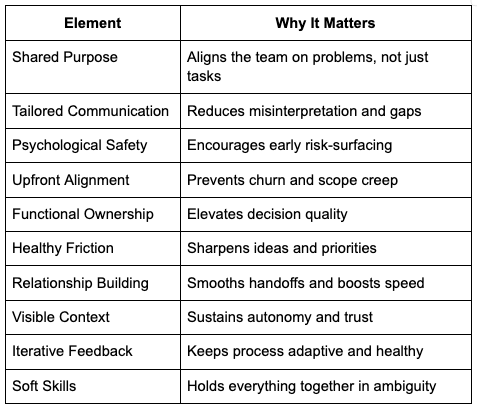Why Cross-Functional Collaboration Feels Hard and How to Get It Right
When I first became a PM, I thought the hardest part would be deciding what to build.
It wasn’t.
The real challenge was aligning a group of people who didn’t report to me—and didn’t always agree—to move in the same direction.
You’re working with engineers focused on scalability, designers aiming for delight, legal scanning for risk, marketers thinking about positioning, and multiple product teams each with their own priorities. Every function speaks a different language, moves at a different pace, and brings its own incentives to the table—all in service of making the product better. And as the PM, you’re expected to create clarity, resolve friction, and keep momentum going.
It’s like conducting an orchestra where everyone’s playing a different instrument.
But when collaboration works, it’s magic:
Execution speeds up
Decisions get sharper
Creativity expands
Trust deepens
It doesn’t happen automatically. It takes deliberate effort, invisible leadership, and a whole lot of listening.
In this post, I’ll share what I’ve learned about leading cross-functional (XFN) teams effectively. This is a playbook built from personal experience and shaped by excellent thinking across the product community.
1. Start With Shared Purpose, Not Tasks
Too often, teams are handed a backlog and told to execute. But great collaboration starts with a shared understanding of the problem.
“What are we solving, for whom, and why now?”
A clearly defined north star, rooted in user needs and business value, gives everyone context and agency. Teams don’t want just direction. They want meaning. Without this shared foundation, even the most talented functions can drift.
Tactic: Kick off every initiative by co-defining the problem, goals, and success metrics. This builds alignment and motivation from day one.
2. Communicate With Context
I’ve learned the hard way that saying something once in a team meeting isn’t enough.
Different functions hear things differently. Engineers focus on scope and feasibility. Legal listens for risk. Design zeroes in on experience. Marketing wants a story they can tell.
My job as a PM is to translate across those lenses while keeping the narrative consistent. Not to spin different versions of the truth, but to frame the same core insight in the way each team can act on.
Your job? Speak their language while keeping everyone grounded in the shared narrative.
Tactic: Use 1-pagers, decision logs, 1:1s and centralized working docs.
3. Build Psychological Safety Early
I’ve been in rooms where people were hesitant to speak up—and others where people felt free to challenge ideas. The difference wasn’t process or structure. It was trust.
Psychological safety is not about being agreeable. It’s about being honest—early. It’s about creating a space where people feel they can say the hard thing early. Where dissent is respected, and risk doesn’t mean reputational damage.
This isn’t about team offsites or icebreakers. It’s about everyday behavior.
A quick litmus test I use to assess team safety:
Do people feel safe sharing dissenting views?
Are wins celebrated cross-functionally?
Are trade-offs discussed openly?
Tactic: Publicly recognize team contributions, invite dissent early, and model transparency, especially around unknowns.
4. Slow Down to Align, So You Can Move Fast Later
There’s always pressure to move fast. But rushing into execution without alignment doesn’t save time—it just delays the pain.
I’ve made the mistake of skipping conversations about ownership, definitions of done, and risk planning. And I’ve seen how that misalignment shows up weeks later as confusion, rework, and frustration.
Take the time up front to:
Align on ownership, decision rights, and escalation paths
Define what “done” means
Anticipate risks via pre-mortems
Tactic: Use frameworks like RACI, RICE, or ICE to define ownership and decision paths, outline risks upfront and work with the team to figure out “What worries you most about this plan?”
5. Let the Experts Lead
Great PMs orchestrate. We connect the dots—but we don’t need to draw them all ourselves.
Some of the best outcomes I’ve seen happened when the PM stepped back and created space for the right function to lead. My role was to make sure those voices came together, not compete. Let each function lead within their expertise.
Tactic: Ask more than you answer. Synthesize instead of controlling.
6. Use Friction as a Signal, Not a Red Flag
Disagreement isn’t a breakdown—it’s often a breakthrough waiting to happen. When people challenge each other, it usually means they care about the outcome and are seeing the problem from different angles.
Friction isn’t the issue. Silence is.
Moments of tension often reveal hidden assumptions, misaligned incentives, or unclear trade-offs. Instead of smoothing things over, surface the disagreement. Make it explicit. Then work through it with structure.
When conflict shows up, pause and ask:
Are we still aligned on the problem and goals we’re solving?
Can we re-ground in facts and metrics—not just opinions?
Are we using the same criteria to make this decision?
Tactic: Treat conflict as a cue to realign, not retreat. The goal isn’t to eliminate disagreement—it’s to make sure it leads somewhere productive.
7. Relationships Drive Execution
Projects rarely get unblocked in meetings. They get unblocked in side conversations, quick pings, or casual syncs with someone who trusts you.
Strong execution depends on strong relationships—built through consistent 1:1s, honest questions, and genuine curiosity about what your partners need (and how they work best).
Don’t just manage the project—know your people.
What motivates them?
What’s blocking them? What are their constraints?
What do they need from you?
Tactic: Regular 1:1s with key stakeholders are not optional. They’re the foundation of influence without authority.
8. Centralize Documentation and Share Generously
In cross-functional work, shared context is everything. A lack of visibility kills velocity.
Make information accessible:
Central docs for every initiative
Meeting notes and action items shared async
Decisions logged in one place
Tactic: Don’t wait until the end to document. Write as you go. Share before meetings to reduce live debates.
9. Create Feedback Loops and Act On Them
Cross-functional work is messy. That’s OK—as long as you’re learning and improving. What worked last quarter might not work today. That’s why feedback should be a regular process.
Normalize feedback on process and leadership
Run regular retros with stakeholders
Iterate not just on product, but on how you work together
Tactic: Ask “What’s one thing we could do better next sprint?”—then show that you listened.
10. Lead With Soft Skills
The systems we build—docs, meetings, frameworks—only work if people trust each other. And that trust is shaped by how we show up.
When things are unclear or tense, people look to the PM to steady the room. Are we consistent? Do we listen well? Are we fair in how we engage across functions?
Self-awareness, empathy, and steadiness don’t just hold the process together—they set the tone for how the team shows up.
Tactic: Be the person people want in the room during a tough conversation.
Recap: The Operating System for Cross-Functional Leadership
Final Thought
Cross-functional collaboration isn’t a side skill—it’s the operating system of great product management.
It’s what turns ambiguity into alignment, tension into momentum, and a group of specialists into a team that ships with purpose.
It’s not always clean. It’s often hard. But when it works, it’s what makes great products possible—and great teams unstoppable.



